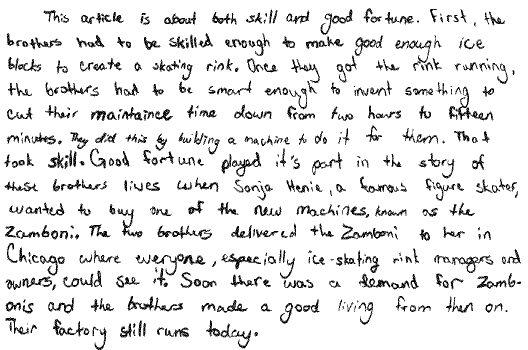
The “Zamboni” Question:
A Typical Grade 8 Reading Prompt
analyzed by Timothy Horrigan, former Measured Progress test scorer
The Montana Grade 8 test recently featured an article entitled “Nice Ice!” by someone named Andrea Jachman. It is the story of the Zamboni brothers and their invention, the ZAMBONI® ice resurfacing machine. (The Measured Progress test booklet refers to the machine simply as a “Zamboni,” which technically violates the Zamboni Company's trademark policy.)
You can get a pretty good idea of what Jachman's story is about just by reading the “anchor” test responses, or you can click here to read it. (The story starts on page 9 of a PDF file, after another Montana Grade 8 reading prompt.)
Basically, Lawrence and Frank Zamboni were “ice men” who made block ice used to ship produce cross country. In the 1940s, their business became obsolete, so they went into a related business: they started a skating rink in Paramount, California. (One of the “anchor 4s” was written by a student who incorrectly deduced that you need good “ice blocks” to make a good skating rink. She evidently deserved credit for taking the phrase “block ice” from the article, even though skating rinks use sheets of ice.) Over the course of several years, the brothers developed a machine (“the Zamboni”) to automate the process of resurfacing the ice.
Their big break came sometime in the early 1950s. (The article doesn't say exactly when.) The great skater Sonja Henie was one of the regulars at the rink. The brothers built her a Zamboni which she took Back East to the Chicago Stadium. To quote the author, “In Chicago, ice rink owners, performers, and arena managers throughout the country received a glimpse of the marvelous Model B.” It was a big hit.
By 1954, the Model E is developed, which is the first Zamboni which could be mass-produced. “In 1958 [the Model E] would gain international attention at the Winter Olympics in Squaw Valley, California.” (The timing of this is a bit surprising, since the Squaw Valley games didn't happen until 1960!)
For More Info:
Click here for Ms. Jachman's complete article. (See page 9 of the PDF file.)
Click here for official Zamboni Company story. (Differs in many details from Jachman's version.)
For 4 Points, The Question is:
The question the kids are asked is totally unanswerable (though, judging by the anchor papers, the kids work hard to try to answer it):
Is this article about good fortune, skill, or both? Explain your answer, using details from the article to support your explanation.
It's impossible to answer the question because there is no dichotomy between “good fortune” and “skill.” Also, “skill” would be something the Zamboni brothers had inside themselves, whereas “good fortune” would be something they experienced (in large part because they successfully utilized their skills.) In any case, it seems that virtually all of the students sensibly answered “both.”
The rubric is as follows:
Score Description
4: Response indicates that this article is about good fortune, about skill, or about both. The response provides a likely and developed explanation that is well supported with specific, relevant details from the article.
3: Response indicates that this article is about good fortune, about skill, or about both. The response provides a likely and adequate explanation that lacks some development and/or some specific, relevant details.
2: Response indicates that this article is about good fortune, about skill, or about both. The explanation is partial and contains limited details as support. The response may contain some misinformation or misinterpretation.
1: Response minimally addresses the question. The response may indicate that this article is about good fortune, about skill, or about both and/or contain a vague explanation with little or no support from the article.
0: Response is totally incorrect or irrelevant.
Blank: No response.
Scoring Notes
Details supporting good fortune:
The Zambonis had not planned to market the machine.
The connection with Sonja Henie meant that the machine got exposure.
The machine’s development coincided with the increase in popularity of ice skating.
Because the machine is used around the world, the Zambonis’ good fortune resulted in financial gain.
Details supporting skill:
The Zambonis were able to adapt their business.
Frank was skilled enough to develop a new machine.
The Zambonis responded to their machine’s popularity by being willing to make more and sell them.
The Zambonis kept improving their machine.
The rubrics are developed long before the test developers see any responses, which means that students are sometimes judged by criteria which have nothing to do with the actual answers. Note, for example, the presence of the first bullet point under “good fortune” about how the brothers did not plan to market the machine. This point (which turns up in none of the anchor responses) is evidently based on an inference which was self-evident only to the test developers. Most people reading this article, including the students who took the test, would be inclined to guess that the Zamboni brothers were planning to eventually market their invention to other rink operators (notwithstanding the fact that a decade or more went by before they started mass-producing their machines.) The fortuitous gift (or, conceivably, sale) of a Model B to Sonja Henie before her Chicago gig, for example, could plausibly be interpreted as a clever marketing ploy. It could plausibly have been more than a naive gesture of mutual appreciation.
This prompt shows another problem with standardized tests: the fact that they have to take a one-size-fits-all approach. This article covers a lot of ground in 700 words. Ms. Jachman tells the story on many levels, which is good since students have wide-ranging interests. But the time for the test is limited, and the story needs to be short enough so everyone in the classroom can read it within the allotted 20 minutes or so (hopefully, with enough time left over to write an answer.) Therefore, there isn't enough room to develop any of the levels fully, so the author ends up telling a rather disjointed story. Worse yet, there is usually only enough time (and only enough funding) to ask one essay question per story (although a few states do occasionally place a 2-point “short answer” question alongside the traditional 4-pointer.) The developers are forced to come up with extremely vague questions which baffle all types of students (no matter what their skills, knowledge, learning styles, etc., may be) equally.
The anchor papers show a wide range of skill levels, and in fact the diversity is minimized here. This sampling doesn't show the 8th-graders (aged 12 to 14) at one end of the scale who are already functioning at college level, nor does it show the students at the other end who are still struggling with grade-school skills.
Anchor Responses:
It looks like everyone (aside from the hapless kids who get 1s and 0s) chose to say that the Zamboni brothers were blessed with both good fortune and skill.
The 3s and 4s are very similar to each other. This is one of those questions where the 4s simply have more details than the 3s. The second anchor 3 exhibits a common problem: the kid chooses to develop a theme rather than simply listing a bunch of details, and gets dinged even though her response is by far the most nuanced in the anchor pack.
The first anchor 4 (with a factually incorrect, but textually justified, reference to “ice blocks”):

The second anchor 4:
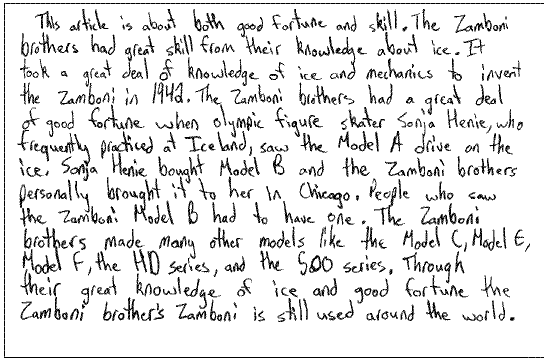
The first anchor 3:
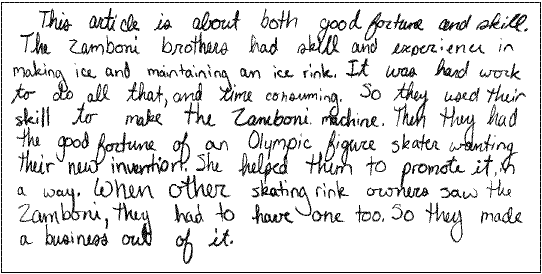
The second anchor 3:
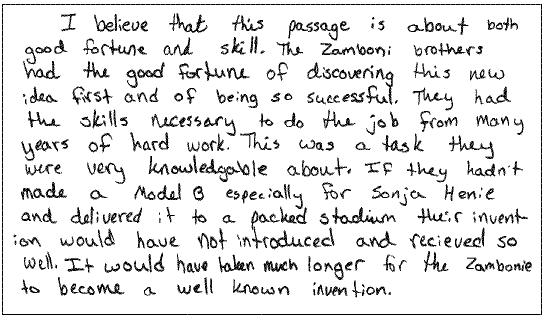
The 1s and 2s are much shorter than the 3s and 4s. The students who show any understanding of the story at all tend to concentrate on the detail of fortune “knocking on the door” in the person of Sonja Henie. They make (vague) references to Ms. Henie literally knocking on the door of the rink. (I do wonder if these students might have given better answers when asked different questions about different reading material.)
The first anchor 2:

The second anchor 2:
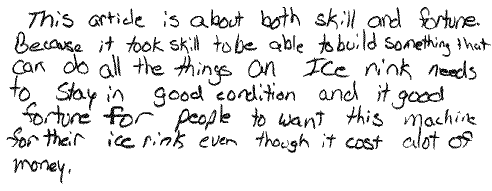
The first anchor 1 (showing how a kid gets a point simply for provding a minimally correct statement):

The second anchor 1 (by someone who actually put a little thought— not much thought, but more than nothing— into his or her answer and still got the same score as the previous kid):

For more information visit: